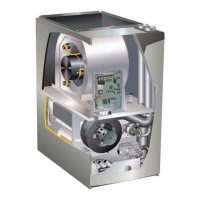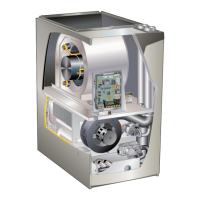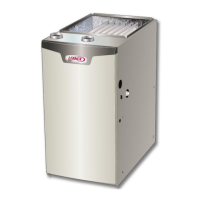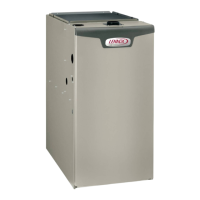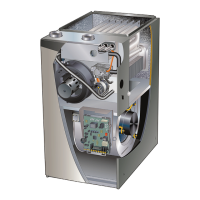Page 51
Applications Using A Single-Stage Thermostat
B - Heating Sequence -- Integrated Control Thermostat
Selection DIP Switch 1 ON in “Single-Stage” Position
NOTE - In these applications, two-stage heat will be initi-
ated by the integrated control if heating demand has not
been satised after the eld adjustable period (7 or 12
minutes).
1 - On a call for heat, thermostat rst-stage contacts
close sending a signal to the integrated control. The
integrated control runs a self- diagnostic program
and checks high temperature limit switches for
normally closed contacts and pressure switches for
normally open contacts. The combustion air inducer
is energized at low speed.
2 - Once the control receives a signal that the low
pressure switch has closed, the combustion air
inducer begins a 15-second pre-purge in low speed.
NOTE - If the low re pressure switch does not close
the combustion air inducer will switch to high re.
After a 15 second pre-purge the high re pressure
switch will close and the unit will begin operation on
high re. After 10 to 20 seconds of high re opera-
tion the unit will switch to low re.
3 - After the pre-purge is complete, a 20-second initial
ignitor warm-up period begins. The combustion air
inducer continues to operate at low speed.
4 - After the 20-second warm-up period has ended, the
gas valve is energized on low re (rst stage) and
ignition occurs. At the same time, the control module
sends a signal to begin an indoor blower 30-second
ON-delay. When the delay ends, the indoor blower
motor is energized on the low re heating speed and
the HUM contacts are energized. The integrated
control also initiates a second-stage on delay
(factory-set at 7 minutes; adjustable to 12 minutes).
5 - If the heating demand continues beyond the
secondstage on delay, the integrated control
energizes the combustion air inducer at high speed.
The control also checks the high re (second stage)
pressure switch to make sure it is closed. The high
re (second stage) gas valve is energized and the
indoor blower motor is energized for operation at the
high re heating speed.
6 - When the thermostat heating demand is satised,
the combustion air inducer begins a 5-second low
speed post-purge. The eld-selected indoor blower
o delay begins. The indoor blower operates at the
low-re heating speed.
7 - When the combustion air post-purge period is
complete, the inducer and the HUM contacts are
de-energized. The indoor blower is de-energized at
the end of the o delay as well as the 120V ACC
terminal.
Service
WARNING
ELECTRICAL SHOCK, FIRE,
OR EXPLOSION HAZARD.
Failure to follow safety warnings exactly could result in
dangerous operation, serious injury, death or property
damage. Improper servicing could result in dangerous
operation, serious injury, death, or property damage.
Before servicing, disconnect all electrical power to
furnace. When servicing controls, label all wires prior to
disconnecting. Take care to reconnect wires correctly.
Verify proper operation after servicing.
WARNING
The blower access panel must be securely in place when
the blower and burners are operating. Gas fumes, which
could contain carbon monoxide, can be drawn into living
space resulting in personal injury or death.
Annual Furnace Maintenance
At the beginning of each heating season, and to comply
with the Lennox Limited Warranty, your system should
be checked as follows:
WARNING
Improper service or maintenance can cause property
damage, personal injury or loss of life. Installation and
service must be performed by a licensed professional
HVAC installer (or equivalent), service agency or the
gas supplier.
1 - Check wiring for loose connections, voltage at
indoor unit and amperage of indoor motor.
2- Check the condition of the belt and shaft bearings if
applicable.
3- Inspect all gas pipe and connections for leaks.
4- Check the cleanliness of lters and change if
necessary (monthly).
5- Check the condition and cleanliness of burners and
heat exchanger and clean if necessary.
6- Check the cleanliness of blower assembly and
clean the housing, blower wheel and blower motor if
necessary
7- Inspect the condensate drain and trap for leaks and
cracks. The drain and trap must also be cleaned
and the trap must be primed with water. Inspect the
rubber hoses connected to the pressure switches for
cracks or loose connections, replace as necessary.
Remove the rubber hoses from the cold end header
box and inspect for any blockage, clean as needed.
If strainers are installed in the hoses remember to
remove and clean before reinstalling the hoses.

